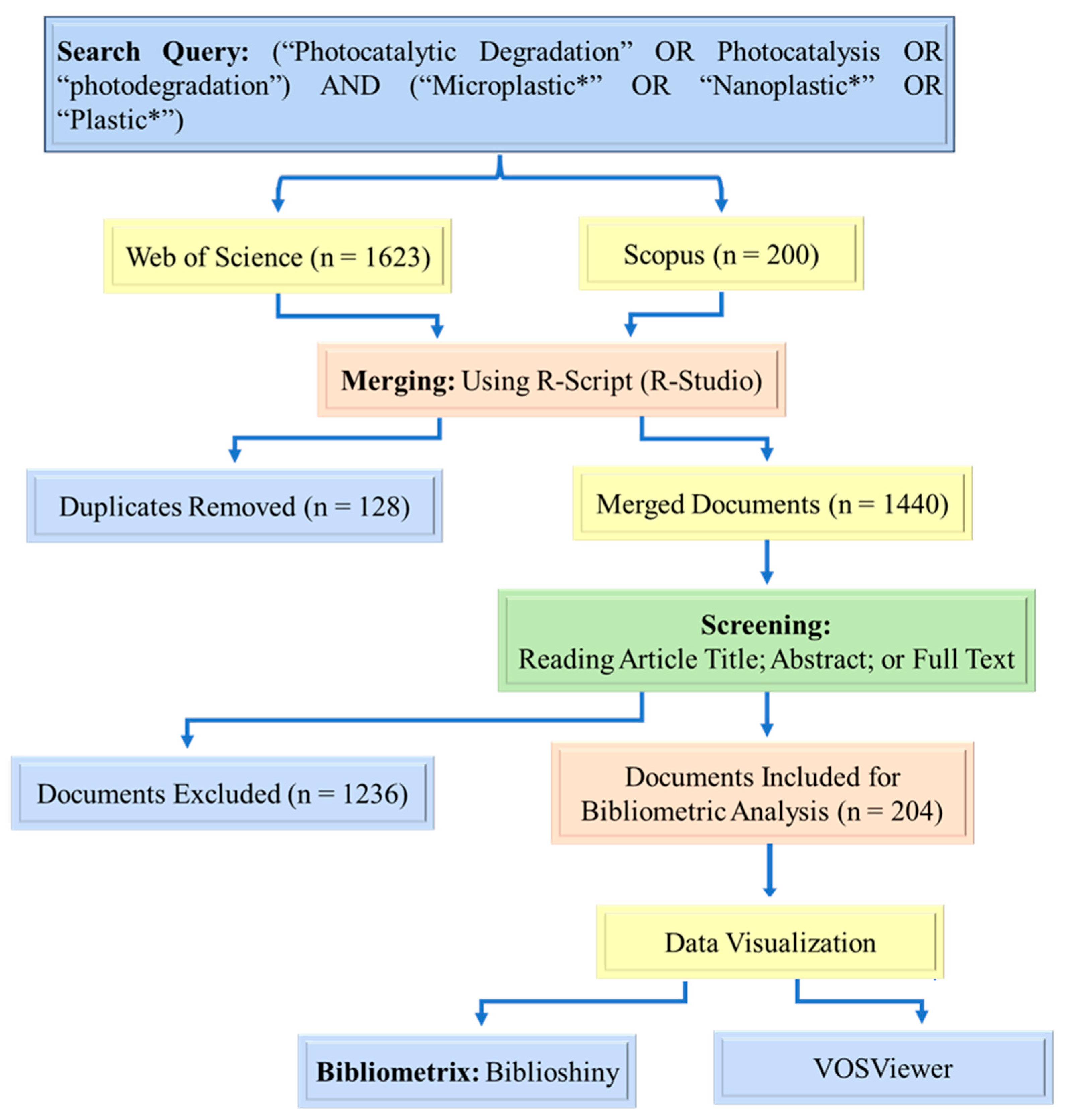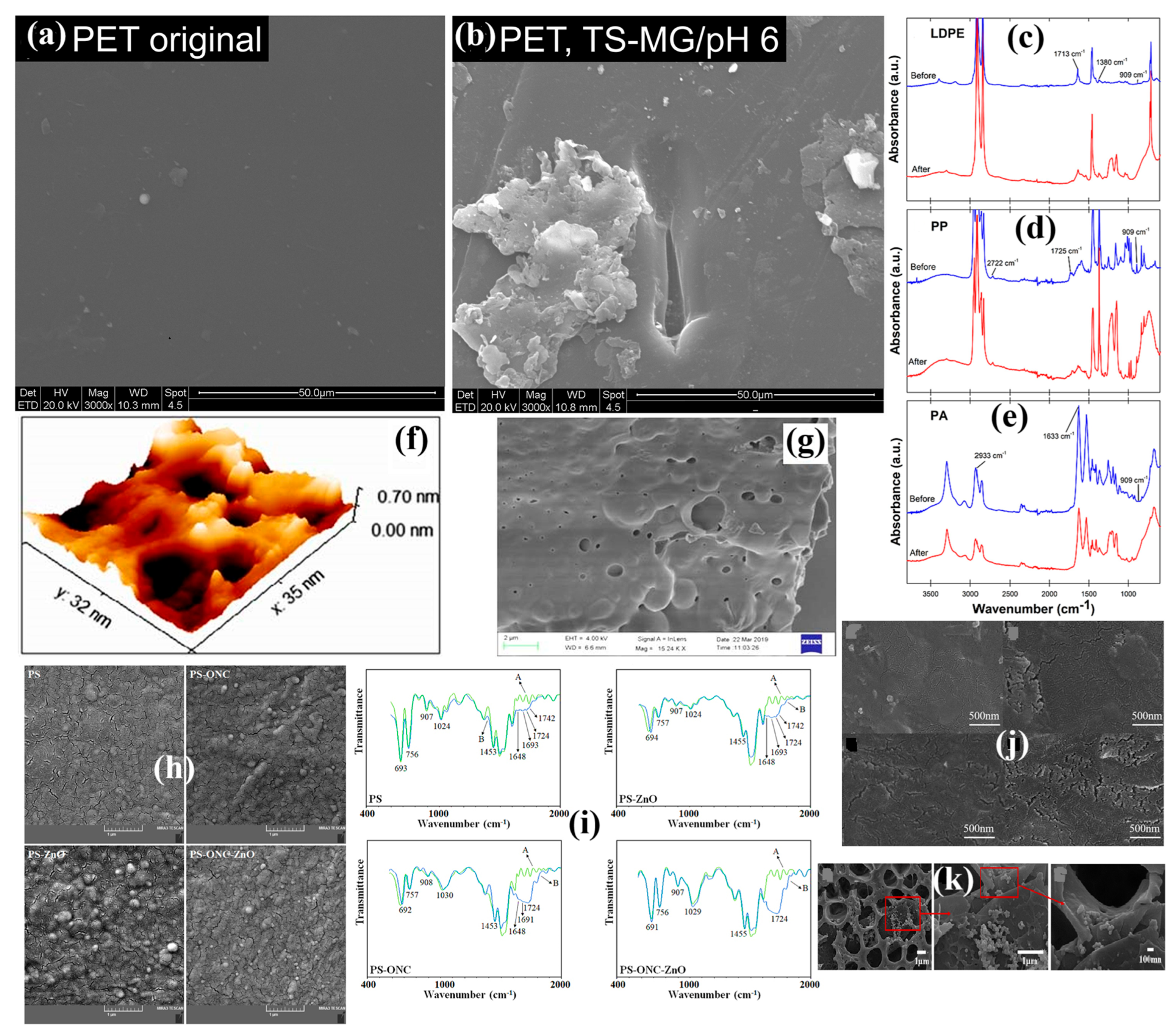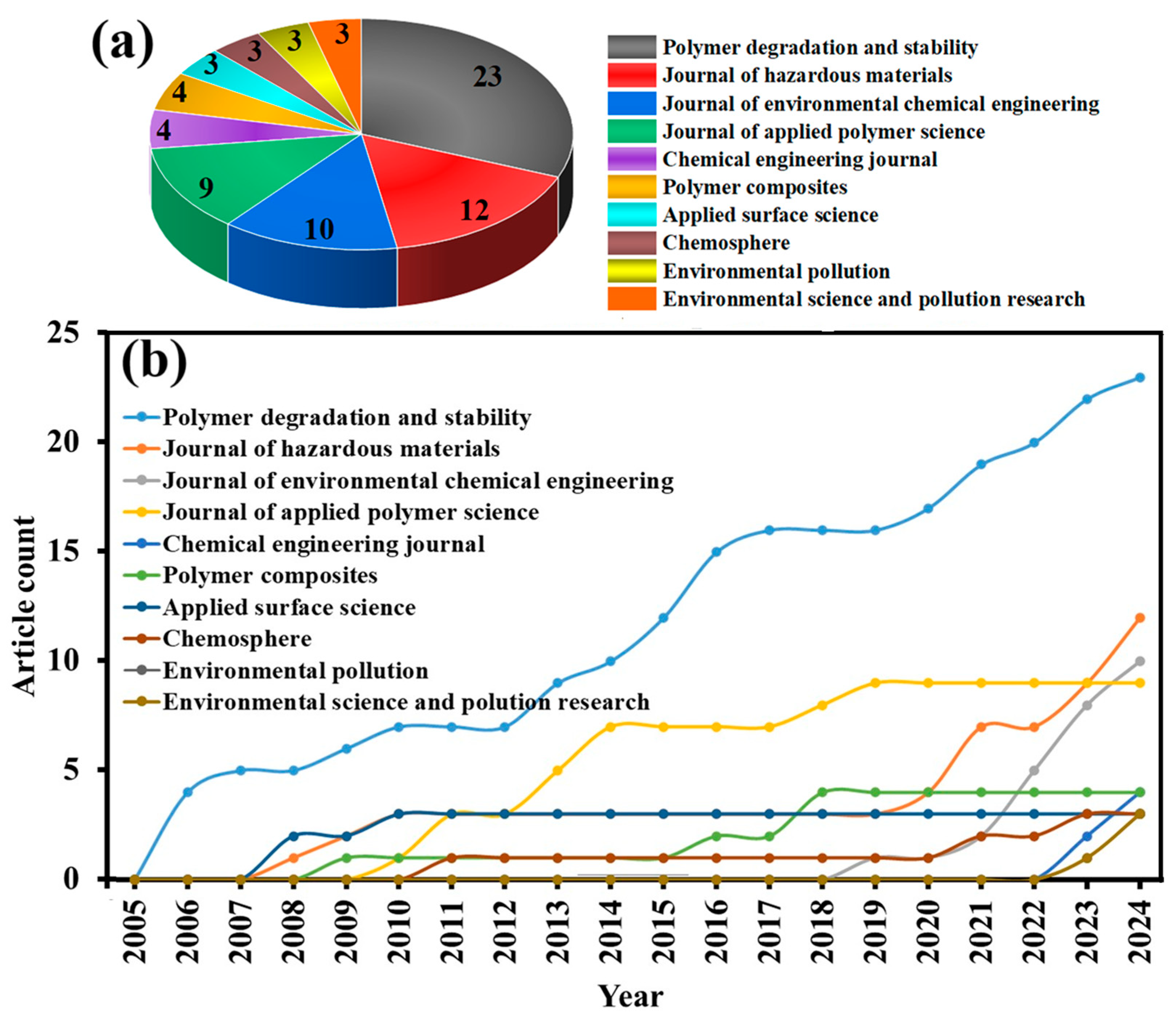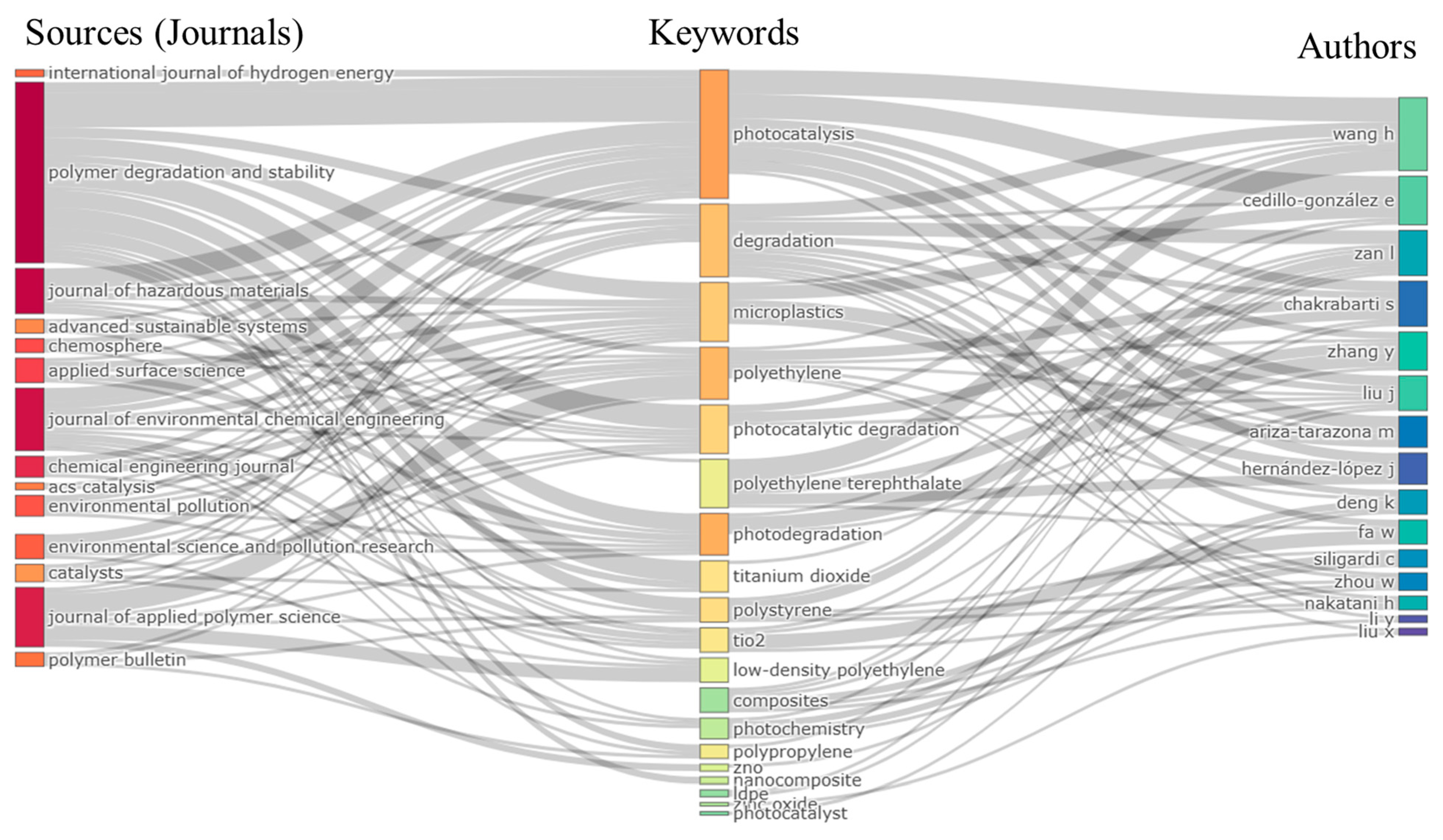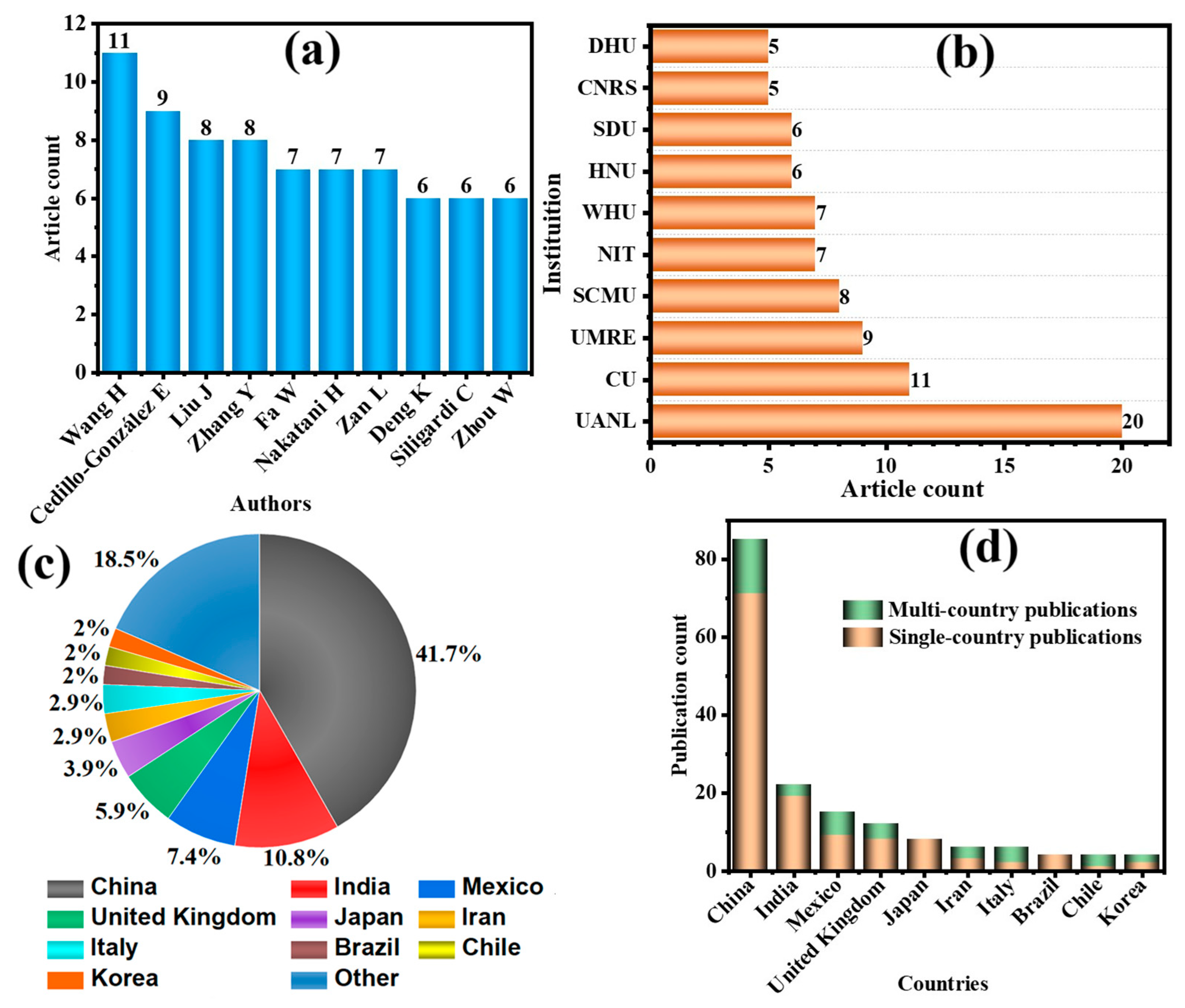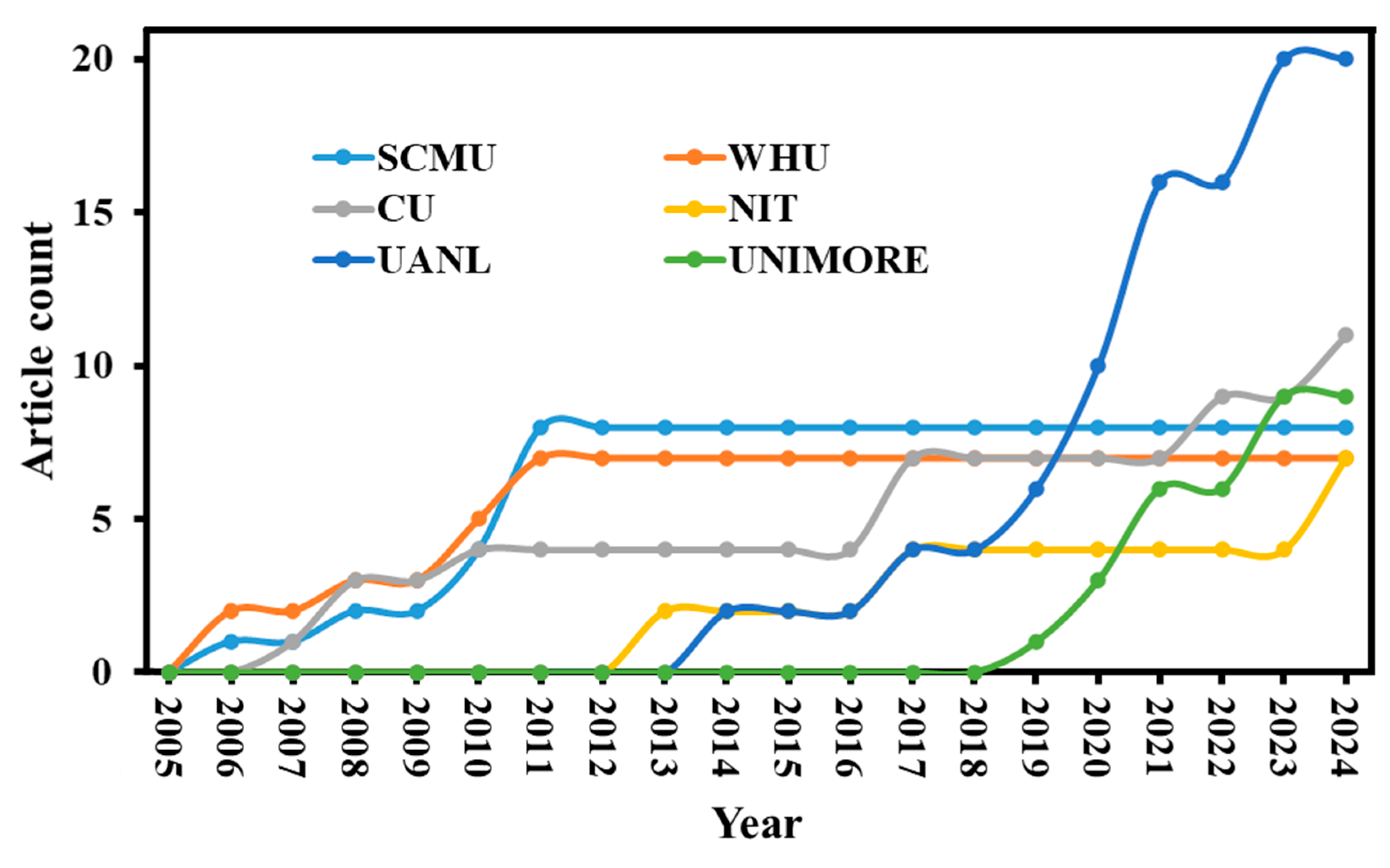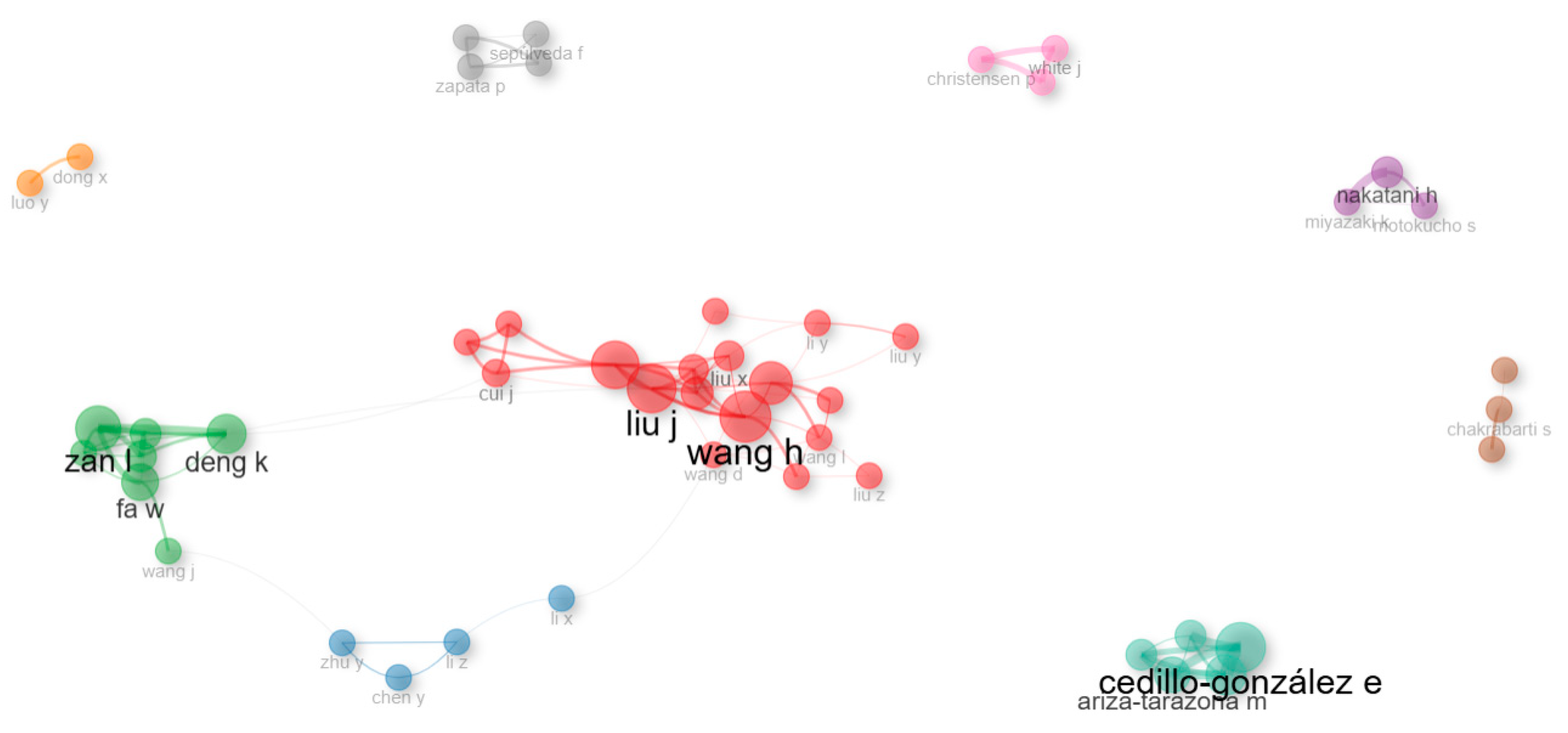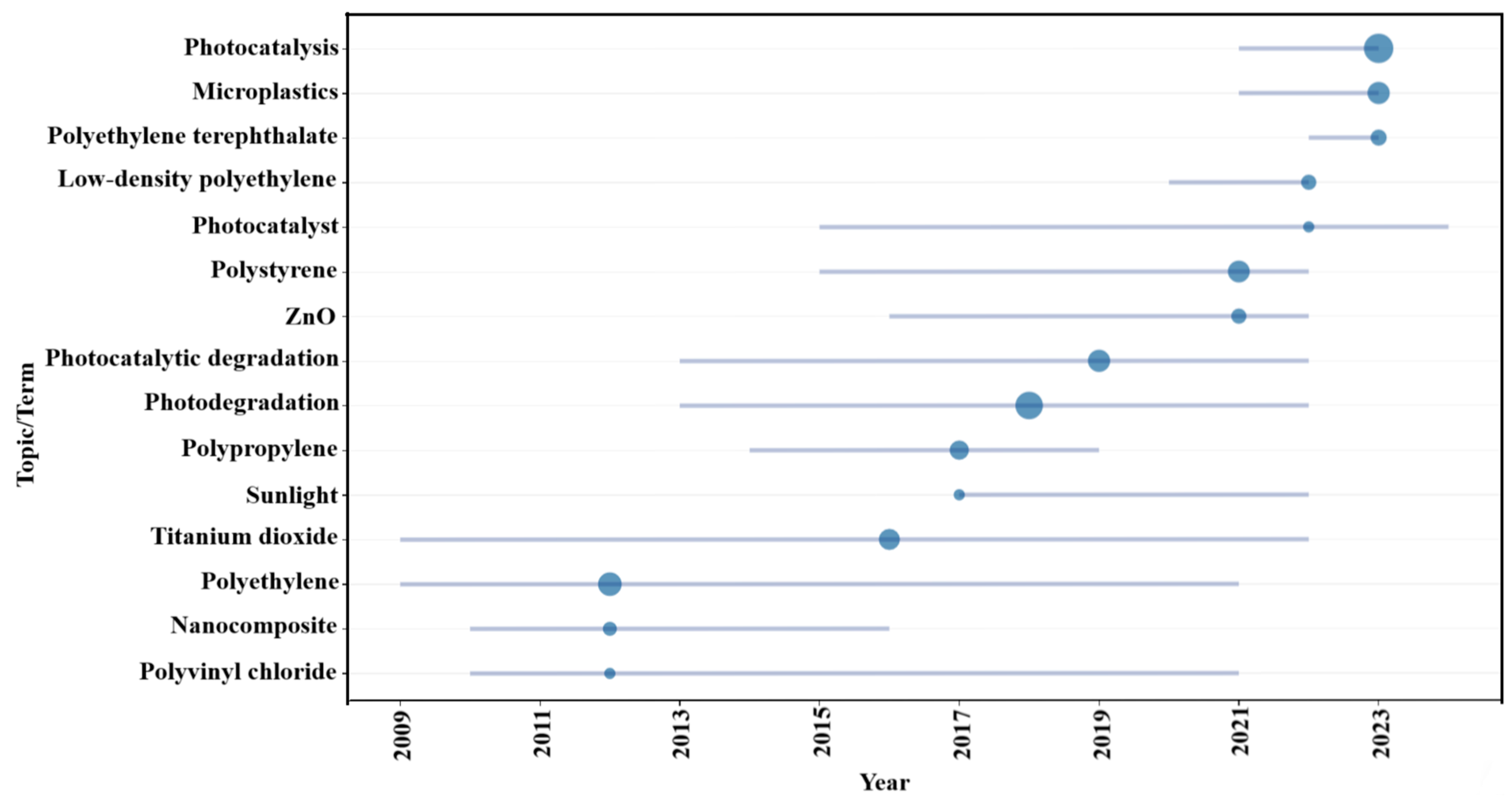1. Introduction
The rise of plastic pollution, particularly microplastics, has become one of the most critical environmental challenges in recent decades. Microplastics, defined as plastic particles less than 5 mm in size, are pervasive across ecosystems, from oceans and rivers to soil and air [
1]. Their persistence in the environment is primarily due to the inherent durability of plastic polymers, which resist natural degradation processes. The increasing production of plastics, coupled with their low recycling rates and improper disposal, has led to a global crisis, as microplastics accumulate and pose risks to human health and ecosystems [
2,
3].
Plastics, such as polypropylene (PP), polyethylene (PE), polystyrene (PS), polyvinyl chloride (PVC), polyethylene terephthalate (PET), polyamide (PA), high-density polyethylene (HDPE), and low-density polyethylene (LDPE), are produced from fossil fuels like petroleum, natural gas, or coal [
4]. Despite the environmental problems caused by plastic pollution, their versatility, durability, low cost, and efficiency have made them essential in various industries, including packaging, construction, transportation, electronics, agriculture, healthcare, and sports [
5]. However, the widespread use of these plastics has led to significant environmental challenges, particularly the accumulation of microplastics, prompting the search for innovative mitigation strategies [
6]. As concerns over microplastic pollution have grown, researchers have explored innovative approaches to mitigate this issue [
2].
One such approach is photocatalytic degradation [
7,
8,
9,
10], a process that harnesses the power of light and catalysts to break down microplastics into smaller, less harmful substances. Photocatalysis involves the use of semiconductor materials, such as titanium dioxide (TiO
2) or zinc oxide (ZnO), which, when activated by light, generate reactive species capable of attacking and degrading plastic polymers [
11,
12]. This method holds promise as a sustainable and environmentally friendly solution to microplastic pollution, particularly in aquatic environments where microplastics are most prevalent. Unlike traditional waste management techniques, photocatalytic degradation can degrade microplastics in situ, minimizing the need for collection and disposal [
13,
14].
Photocatalysis is attractive because it utilizes renewable energy sources, such as sunlight, to drive the degradation process. This aspect makes it an attractive solution for reducing the environmental impact of microplastics, particularly in remote or large-scale environments like oceans and lakes where traditional cleanup methods are not feasible. Photocatalysis offers the potential to reduce microplastic particles to their molecular components, ultimately minimizing the risk of further environmental contamination. Additionally, this approach is eco-friendly, as it does not rely on harsh chemicals or energy-intensive processes, aligning with global efforts toward sustainable environmental management [
15,
16,
17].
However, despite the growing body of research on photocatalytic degradation of microplastics, there is a need for a clearer understanding of the global research landscape in this field. Bibliometric analysis is essential for understanding a research field, as it effectively maps the intellectual structure and identifies trends within that domain. Quantitatively analyzing academic publications allows researchers to identify patterns, key contributors, influential papers, and emerging trends. Bibliometrics can uncover hidden connections within a field, providing insights into how research evolves and highlighting areas of high activity or potential gaps in knowledge. This approach is particularly valuable in fast-growing research areas like photocatalytic degradation of microplastics, where keeping track of the vast and diverse literature can be challenging [
18,
19].
While review papers often summarize recent developments, identify challenges, and propose future research directions, bibliometric analysis takes a systematic, data-driven approach to evaluate global research patterns in specific fields by analyzing literature indexed in academic databases. Initially more familiar within social sciences, library sciences, and informatics, bibliometric analysis has become an increasingly valuable tool across diverse disciplines, allowing researchers to quantify publication trends, map influential authors and institutions, and identify prominent research themes and gaps. Applying bibliometric analysis to the field of photocatalysis provides a fresh methodological perspective, offering insights into dominant research topics, collaboration networks, and evolving research trajectories. This approach highlights current research hotspots and forecasts emerging directions, supporting a comprehensive understanding of the field’s progression and potential future developments [
20].
Bibliometric analysis has been significantly enhanced through the development of specialized software tools such as Bibliometrix [
21,
22], VOSviewer [
23,
24], and CitNetExplorer [
25]. These tools facilitate efficient visualization and comprehensive analysis of bibliographic data, providing researchers with advanced capabilities to map out scientific landscapes. Across numerous disciplines, researchers use bibliometric tools to assess research performance, identify emerging trends, and understand the broader patterns within specific fields of study [
26]. For example, Pauna et al. [
27] conducted a bibliometric network analysis on the scientific literature concerning microplastics in marine ecosystems. Utilizing VOSviewer, they analyzed keyword co-occurrence, author collaborations, and citation patterns to visualize the research landscape. Kek et al. [
28] performed a bibliometric analysis of sustainable strategies for reducing indoor microplastics and converting them into value-added products. The study used data from the Web of Science to map research trends, citation patterns, and collaborations. Zhang et al. [
29] reported a study on bibliometric analysis of global trends and prospects in microplastic research. Mehta and Kozielska [
30] integrated bibliometric analysis to perform a systematic literature review on sources and analytical approaches of indoor microplastics.
This study utilizes a bibliometric approach to examine global research trends in the photocatalytic degradation of microplastics. By analyzing data from leading scientific databases such as Web of Science and Scopus, we aim to provide a comprehensive overview of the current research landscape, highlighting influential studies, key researchers, and dominant research areas [
31]. The Web of Science Core Collection (WoS) and Scopus are leading multidisciplinary databases providing extensive bibliographic information across various research domains. WoS has over 1.9 billion cited references and 85.7 million scholarly records spanning 254 disciplines. At the same time, Scopus offers access to 87 million documents, 1.8 billion citations, and data from 94 thousand affiliations and 7.5 thousand publishers. Independently utilizing WoS and Scopus databases can lead to redundancy and complexity due to overlapping content, making it necessary to eliminate duplicates. It is recommended that metadata be unified for efficient bibliometric research, as each database has unique features [
32,
33]. Merging both datasets provides comprehensive time coverage, includes new literature, and enhances the accuracy of measuring authors’ impact, thereby improving the analysis of evolutionary citations [
19]. User-friendly methods are available—using R packages and Excel—for merging WoS and Scopus datasets while maintaining data integrity [
33,
34].
Therefore, the primary objective of this study was to conduct a detailed bibliometric analysis of global research on this topic. Specifically, the study seeks to address the following objectives: (1) Identify global research trends by analyzing publication patterns over time to determine periods of rapid growth, the distribution of research efforts across regions, and the evolution of interest in this field. (2) Highlight key contributors by identifying leading countries, institutions, and researchers through co-authorship networks and affiliations, revealing collaboration patterns and geographical expertise concentrations. (3) Evaluate influential publications by identifying the most highly cited studies, journals, and conferences that publish research on this topic, providing insights into impactful works and dissemination channels. (4) Explore emerging trends by analyzing the latest developments to identify new research topics. (5) Identify research gaps by mapping the current research landscape to highlight areas needing further investigation, thereby guiding future research initiatives.
3. Results and Discussion
3.1. Advancements in Research Interests and Publication Output
Table 1 presents a summary of key primary information deciphered by Bibliometrix. It highlights key bibliometric metrics such as the annual growth rate, the analyzed period’s duration, the total number of documents included, and the primary sources contributing to the dataset.
The bibliometric analysis of photocatalytic degradation of microplastics and nanoplastics reveals a growing research interest in this field over the past two decades (2005–2024). The 17.94% annual growth rate highlights the accelerating pace of scientific contributions driven by increasing environmental concerns. A total of 204 articles from 112 sources were analyzed, with an average of 31.75 citations per document, indicating a strong impact and relevance of the research. The field exhibits a high level of collaboration, with an average of 5.42 co-authors per document and 25.98% international co-authorships, reflecting a global research effort. The document average age of 5.91 years suggests this is a relatively young yet rapidly evolving field. The analysis also highlights an extensive knowledge network, with 624 Keywords Plus (ID) and 522 Author’s Keywords (DE), demonstrating the multidisciplinary nature of research in photocatalytic degradation of plastic pollutants. However, the presence of only two single-authored documents suggests that individual contributions are rare, emphasizing the collaborative nature of this research domain. The bibliometric trends indicate a dynamic and expanding scientific landscape, underscoring the urgent need for sustainable microplastic and nanoplastic pollution solutions.
Industries discharge substantial quantities of wastewater into lakes and rivers, resulting in significant environmental pollution [
42]. Traditional water treatment methods often need to catch up regarding long reaction time, efficiency, and cost-effectiveness [
43]. In recent years, photocatalysis has emerged as a promising alternative for wastewater treatment. This method is particularly appealing due to its effectiveness in degrading pollutants through redox reactions and its ability to utilize sunlight, an abundant and free energy source [
44]. Consequently, there has been a notable increase in research and publications focusing on photocatalytic wastewater treatment. Photocatalysis has been explored as an effective method for removing microplastics from water. This advanced treatment process can be integrated as a tertiary stage in wastewater treatment plants, enhancing their ability to address microplastic pollution. During photocatalysis, microplastics undergo degradation, breaking down into carbon dioxide and water or converting into molecular species that are generally less toxic. This finding makes photocatalysis a promising option for mitigating the environmental impact of microplastics in wastewater treatment [
7].
In addition, the United Nations Sustainable Development Goals (SDGs), particularly Goal 6, which targets access to clean water and sanitation for all by 2030, have sparked considerable interest and engagement within the research community [
45]. The urgency of addressing global water scarcity and pollution, coupled with the need for sustainable management of water resources, has motivated scholars to focus on developing innovative and environmentally sustainable solutions for water treatment. These goals highlight the importance of tackling the adverse effects of water contamination, including emerging pollutants such as microplastics, and emphasize adopting economically feasible technologies that minimize environmental impact. Consequently, the SDGs have become a driving force for research initiatives to advance water purification methods that are effective and sustainable long-term, aligning with global efforts to safeguard water resources for future generations [
19].
The earliest photocatalysts identified were wide bandgap semiconductors [
46]. While these materials are effective, they have significant limitations, primarily their ability to absorb light only in the ultraviolet spectrum, which restricts their photocatalytic efficiency. It is important to note that solar energy contains only about 3–5% UV radiation, while visible light constitutes approximately 43% of solar energy. This observation implies that a considerable portion of solar radiation remains untapped. Considering this, there is an increasing focus on developing visible-light-driven narrow bandgap semiconductors that can effectively absorb light in the visible spectrum, thereby enhancing photocatalytic activity and utilization of solar energy [
20,
47].
3.2. Overview of Photocatalysts for Nano- and Microplastic Degradation
Table 2 summarizes recent studies on photocatalysts for degrading different nano- and microplastics. It lists the photocatalyst types, synthesis methods, targeted plastics, irradiation sources, reaction times, and degradation efficiencies, highlighting diverse approaches and their potential for sustainable plastic degradation.
Photocatalytic degradation of nano- and microplastics under UV, sunlight, and visible light have been explored in multiple studies employing various advanced photocatalysts [
7,
8,
9,
10,
46,
47,
48,
49,
50,
51,
52,
53,
54,
55,
56], with distinct mechanisms and material-specific properties aimed at mitigating plastic pollution effectively.
Table 2 provides a comprehensive summary of photocatalysts used in these studies. The bio-inspired C,N-TiO
2/SiO
2 photocatalyst synthesized using extrapallial fluid from
Mytilus galloprovincialis for PET degradation under visible light exemplifies innovation in materials design. The catalyst’s high surface area and suitable bandgap energies enabled degradation efficiencies ranging from 9.35% to 16.22% after 120 h, particularly under acidic conditions (pH 6). The degradation process was confirmed using structural and thermal analyses, revealing significant changes in PET properties and surface morphology (
Figure 2a,b), with enhanced activity attributed to synergistic carbon and nitrogen doping [
7].
Similarly, CuO/BiVO
4 nanocomposites were explored for degrading LDPE, PP, and PA via an enhanced photo-Fenton process. The formation of a p–n heterojunction between CuO and BiVO
4 enhanced charge transfer and promoted the generation of reactive oxygen species (ROS). This facilitated efficient oxidation processes, leading to effective polymer breakdown, as demonstrated by the increased carbonyl and vinyl indices (
Figure 2c–e). However, the treated water showed some toxicity, highlighting the necessity for dilution before discharge [
8]. Another notable system reported by Qi et al. [
9] is Ni
2P/TiO
2/C nanofibers (NFs). This system achieved efficient charge separation and reduced electron–hole recombination during PET degradation under visible light, with KOH pretreatment further enhancing degradation performance [
9]. In the case of BiOCl-ZrO
2, degradation of LDPE under visible light resulted in a 48.67% weight reduction over 24 days, with a type-II heterojunction improving charge separation and reducing recombination. The process, however, had a measurable carbon footprint, emphasizing the need for further optimization to align with sustainable development goals [
10].
Studies have also explored the use of Fe
3O
4 particles and composites, such as Fe
3O
4/g-C
3N
4, which leverage magnetic properties for easy separation and redox cycling to generate radicals under UV-A light, achieving PET degradation rates up to 40% in 8 days [
49]. A Z-scheme photocatalyst, g-C
3N
4/WO
3, demonstrated efficient PET degradation and hydrogen production under visible light, with enhanced ROS formation facilitating the breakdown of polymer chains [
50]. BiOCl nanostructures were tested for PS degradation, where BiOCl nanodisks achieved superior performance compared to nanoflowers due to efficient ROS generation. This is evidenced by surface roughness (
Figure 2f) and cavity formation (
Figure 2g) [
51]. A composite of TiO
2-polyaniline (PANI) demonstrated an enhanced charge separation due to strong TiO
2-PANI interactions leading to improved chain scission and photo-oxidation. The composite also showed significant weight loss of PS due to volatile gas formation during degradation, offering a practical approach for PS waste treatment [
52].
Innovative photocatalysts such as graphene oxide-zinc oxide (GO-ZnO) composites and ZnO nanoparticles (ZnO NPs) have shown promise for LDPE and sewage-derived plastics degradation, respectively. GO-ZnO achieved a 39.47% mass loss of LDPE under UV light in just 2 h due to improved charge separation, while ZnO NPs demonstrated effective degradation of various polymers, including PE, PP, PVC, and PET, as confirmed by Raman and FTIR spectra [
53,
54]. Additionally, C,N-TiO
2 achieved 71.77% degradation efficiency of HDPE under visible light in 50 h, with enhanced activity attributed to hydroperoxide formation and increased MP surface area through fragmentation [
48].
Soil-mediated photocatalytic degradation using components like clay, iron oxides, and MnO
2 highlighted the critical role of environmental catalysts in enhancing polymer breakdown. The interplay between MPs and soil components, particularly clay minerals and iron oxides, facilitated degradation through electrostatic interactions, as confirmed by SEM and ATR-FTIR analyses (
Figure 2h–j) [
55,
56]. Moreover, advanced composites like CuO/Bi
2O
3/g-C
3N
4 achieved 41.60% degradation of PET MPs under sunlight. Similarly, photodegradable PVC films with nano-graphite and TiO
2 showed a 17.24% weight loss under UV irradiation. SEM images revealed surface porosity and a honeycomb-like structure (
Figure 2k), demonstrating promising degradation performance through enhanced charge separation and ROS generation [
57,
58].
3.3. Document Types and Quantities
In this study, 1823 records related to microplastic research were retrieved. In the beginning, the statistical data of the studies were sorted and analyzed to draw preliminary conclusions on research trends. The documents were classified into seven distinct categories (
Figure 3a), with the largest share being original research articles, accounting for 86.5% of all publications. Review articles and proceeding papers accounted for 5.3% and 5.8%, respectively. Early access (1.3%), book chapters (0.9%), editorial letters (0.1%), and retracted publications (0.1%) were among the less significant categories. The predominance of original research articles is a key indicator of growth and evolution within microplastic research. Therefore, the analysis focused primarily on original research articles on the photocatalytic degradation of nano/microplastics to better capture trends, advancements, and knowledge gaps in the field. This focus enables a detailed evaluation of the core literature shaping the direction of microplastic research.
The annual production of articles and citation data in
Figure 3b and
Table S1 (Supplementary Materials) highlights important trends regarding the progression, impact, and development of research in photocatalytic degradation of nano/microplastics. From 2005 to 2014, scientific production was relatively low and fluctuated moderately, with publication numbers ranging between 1 and 11 per year. However, after 2018, there was a noticeable increase in publications, marking a sharp rise in 2021. This upward trend peaked in 2023 with 37 publications, indicating a growing research interest. Although there was a slight decrease in 2024 to 23 publications (please note that by 25 October 2024, only 81.69% of the year is considered), the overall trend suggests heightened awareness and increased research activity over recent years. The problem of nano/microplastics has become a prominent environmental concern, driving heightened academic and research interest. This rise likely reflects increased awareness of microplastic pollution’s ecological and health risks, leading to more funding and a greater focus on finding effective mitigation solutions [
28,
59].
The mean total citation per year reveals fluctuating impact over time. Initially, between 2005 and 2013, the average citations were relatively low and inconsistent. A significant increase in citations began in 2019, reaching a peak of 13.11 and 12.62 citations per year in 2020 and 2021, respectively. These peaks may reflect highly influential studies or growing recognition within the field. However, the mean citation rate has declined recently, with 2024 averaging only 2.22 citations per paper, likely due to the shorter period for citations to accumulate. This trend suggests both growing research interest and variation in the immediate impact of recent studies.
The trend in publication volume does not usually align with the average citation pattern. It is common to experience a delay between when a document is published and when it begins to receive citations. This delay is known as citation lag [
60]. Such a lag arises because newly published research requires time to be discovered, read, and cited by other scholars in their subsequent works. As a result, even in fields where the number of publications is increasing, indicating a positive growth trend, the citation counts for more recent articles tend to be lower than those for older publications. This phenomenon occurs because the research community needs time to absorb and integrate new findings into their work, which is then reflected in citation records [
61]. This phenomenon is a normal aspect of the scholarly communication process and highlights the iterative nature of research and the dissemination of knowledge. It underscores the fact that while publication rates may rise, citation practices often lag, reflecting the gradual process through which new information gains recognition and influence within the academic community [
19].
3.4. Source Dynamic Production
Figure 4 shows leading journals and cumulative journal production over time. As shown in
Figure 4a,
Polymer Degradation and Stability stands out as the leading journal with 23 articles on this topic, reflecting its focus on materials degradation, particularly polymers, which aligns well with the study of plastic breakdown in environmental contexts. The
Journal of Hazardous Materials follows with 12 articles, emphasizing the hazardous nature of micro- and nanoplastics and the importance of developing effective degradation strategies to mitigate their environmental impact. The
Journal of Environmental Chemical Engineering and
Journal of Applied Polymer Science also have significant contributions, with 10 and 9 articles, respectively. These journals cover areas relevant to the environmental chemistry of degradation processes and the engineering challenges associated with using photocatalytic materials to address plastic pollution.
Figure 4b shows the growth in publication output over time for each journal, revealing trends in scientific attention toward photocatalytic degradation of plastics.
Polymer Degradation and Stability has steadily increased in publications since 2006, leading the field and likely reflecting ongoing advancements in understanding polymer stability and breakdown. The
Journal of Hazardous Materials began contributing significantly in 2008 and has recently increased awareness of the environmental hazards associated with micro- and nanoplastics. The
Journal of Environmental Chemical Engineering saw a sharp increase starting around 2019, suggesting recent developments in applying chemical engineering principles to this environmental challenge.
Table 3 provides metrics for the journals, such as the h-index, g-index, m-index, total citations (TC), number of publications (NP), and the year of publication start (PY_start). For example,
Polymer Degradation and Stability has an h-index of 15 and a g-index of 23, indicating both the productivity and impact of its publications in this field. Meanwhile, the
Journal of Hazardous Materials has a higher total citation count (1072) despite a lower number of publications, suggesting that its articles are highly influential, possibly due to their focus on addressing hazardous aspects of plastic pollution. Journals like the
Chemical Engineering Journal and the
Environmental Science & Technology are recent but impactful contributors in this field, showing high m-index values and rapid citation accumulation, indicating that newer publications garner attention and may be pivotal in advancing photocatalytic degradation techniques.
3.5. Three Field Plot
The three-panel plot in
Figure 5, also known as the tripartite Sankey Diagram, provides a comprehensive visualization of the relationships among authors, authors’ keywords, and journals (sources) in the photocatalytic degradation of the microplastics research field. The three-panel visualization illustrates the interconnections among research keywords, influential authors, and key publication sources in this research field. The keywords panel shows the core concepts being studied, such as photocatalysis, degradation, photodegradation, polyethylene terephthalates, polyethylene, microplastics, and polystyrene. The density and interconnections between these keywords suggest they are closely related and central to the research. The author’s panel identifies the key researchers contributing to this work. Prominent authors such as Wang H, Cedillo-González E, Zan I, and Chakrabarti S emerge as key contributors, reflecting their impactful publications and significant collaborative efforts in the field. The sources (journals) field reveals the top publication outlets for this research, including the
Journal of Hazardous Materials,
Journal of Applied Polymer Science, and
Polymer Degradation and Stability. The thick connections between specific journals suggest they are frequently cited together, reflecting their topical relevance.
3.6. Leading Authors, Institutions, and Countries
A comprehensive analysis of photocatalytic degradation of microplastics research is provided in
Figure 6 and
Table S2 (Supplementary Materials). Seven hundred and ninety-four authors have contributed to the field, notably in Asia and Europe.
Figure 6a ranks authors by article count, with Wang H and Cedillo-González E leading with 11 and 9 articles, respectively. This observation aligns with the data provided in
Table 4, where both authors also have high h-indices (8), suggesting that their work has garnered substantial recognition and citations over time. However, other authors in
Figure 6a with similar article counts, such as Zan L, Deng K, and Fa W, show varied h-indices, g-indices, and total citations (TCs) in the table. These results indicate that while they have produced comparable quantities of articles, the impact and citation frequency differ across individuals.
Table 4 also provides insights into when each author started publishing in this field (PY_start), which can explain some of the trends in
Figure 6a. For instance, authors like Zan L and Deng K, who began publishing in 2006, have had more time to accumulate articles, possibly contributing to their presence in
Figure 6a. In contrast, Cedillo-González E, who only started publishing in 2019, has achieved a comparable article count in a shorter timeframe, further highlighted by a high m-index of 1.333 (
Table 4). This m-index, representing the h-index normalized by years since the first publication, suggests a rapidly growing impact for newer researchers.
Additionally, some authors have higher g-indices and total citations despite fewer articles, as seen with Siligardi C and Hernández-López J, indicating their work may be particularly influential or widely cited. Therefore, while
Figure 6a illustrates publication quantity,
Table 4 provides a broader perspective on each author’s research impact, publication timeline, and citation metrics. The article count alone does not fully capture the academic influence of these authors. The impact metrics from
Table 3 complement
Figure 6a by revealing the quality and influence behind the publication numbers.
Figure 6b presents the top institutions involved in this field, with Universidad Autonoma de Nuevo Leon (UANL, Mexico) contributing the highest number of publications (20), followed by University of Calcutta (CU, India) and Universita Di Modena E Reggio Emilia (UNIMORE, Italy). This concentration of publications in specific institutions suggests that these centers have dedicated resources and facilities for advancing environmental remediation techniques. Institutional leadership like this is important because it fosters collaboration with industry and governmental organizations, potentially facilitating the translation of research findings into practical technologies for wastewater treatment. These high-output institutions can drive technological advances and influence global research priorities in addressing plastic pollution [
62].
As illustrated in
Figure 6c, China produced the highest volume of publications of 85 articles, representing 41.7% of the total output. India follows with 22 articles (10.8%), then Mexico (15 articles, 7.4%), the United Kingdom (12 articles, 5.9%), and Japan (8 articles, 3.9%). Meanwhile, contributions from India and Mexico reflect a rising interest in addressing microplastic contamination in diverse regions, highlighting an emerging awareness and prioritization of environmental sustainability in developing countries. This trend aligns with global research funding shifts and environmental policies emphasizing sustainable technologies and pollution management.
Figure 6d distinguishes between single-country publications (SCPs) and multi-country publications (MCPs), revealing collaboration patterns. China’s high SCP rate indicates strong domestic research capacity, while countries such as Italy and Iran show higher MCP rates, emphasizing international collaboration to leverage diverse expertise. This collaborative trend is particularly valuable in photocatalysis, where interdisciplinary knowledge in materials science, environmental science, and engineering is necessary to develop practical solutions for microplastic degradation. International partnerships can foster innovation through shared resources, enabling more comprehensive research outcomes and optimizing photocatalytic applications across different environmental contexts. The partnerships align with research growth, suggesting that countries with fewer resources benefit significantly from international collaboration in specialized fields, allowing for broader adaptation and implementation of technology solutions [
63].
The publication output from various academic affiliations over time is illustrated in
Figure 7. From the figure, a notable increase in research activity since around 2015 is observed.
Universidad Autónoma de Nuevo León (UANL,
Mexico) demonstrates the most significant growth, particularly after 2018, which suggests an intensified focus on this research area in recent years. In contrast, the
University of Calcutta (CU,
India) and
Wuhan University (WHU,
China) show steady outputs, reflecting consistent contributions over time but with less rapid recent growth than
Universidad Autónoma de Nuevo León. South Central Minzu University (SCMU,
China) began contributing earlier and maintained a relatively stable publication rate, indicating an early and sustained interest.
Additionally, Università di Modena e Reggio Emilia (UNIMORE, Italy) and the National Institute of Technology (NIT, India) show moderate contributions, with more gradual increases in their publication output. These trends reflect the growing global attention to environmental sustainability and pollution, particularly concerning micro- and nanoplastics. The trend in the figure suggests that institutions from diverse regions are increasingly prioritizing research on photocatalytic degradation to address the environmental challenges associated with plastic pollution.
3.7. Journal Co-Citation Analysis
Analyzing the most cited articles provides insight into the key studies driving research in photocatalytic degradation of microplastics. This information shown in
Table 5 is valuable for understanding foundational and influential works and identifying impactful authors and trends within the field. The highest-cited paper, authored by Tofa et al. in 2019 [
64] and published in
Environmental Chemistry Letters, has accumulated 278 citations, with an average of 46.33 citations per year and a normalized citation count of 4.35. Following this, Uheida’s 2021 [
65] study in the
Journal of Hazardous Materials has received 273 citations, showing strong yearly growth with 68.25 citations per year and a high normalized citation count of 5.41, indicating a significant recent impact.
Table 4 highlights the
Journal of Hazardous Materials as a key outlet, featuring multiple influential papers, such as Ariza-Tarazona’s studies from 2020 [
48] and 2019 [
66], with 238 and 210 citations, respectively. This journal serves as a core source for advancements in photocatalytic degradation, contributing extensively to the research on this topic. Other impactful journals include
Polymer, where Zhao’s 2006 article [
67] garnered 232 citations, and
iScience, with Nabi’s 2020 [
68] publication receiving 193 citations and a robust annual citation rate of 38.60. The reported data reveals a mix of older foundational studies and recent publications with rapidly growing influence. Notably, work by Cao and colleagues [
69] in the
Journal of Colloid and Interface Science has already amassed 122 citations at an impressive rate of 40.67 per year, signifying the ongoing relevance and dynamic interest in recent research contributions. These highly cited articles underscore key studies and journals that have shaped the field of photocatalytic degradation of microplastics, indicating both established and emerging research trajectories.
Table 5.
Summary of most cited articles on photocatalytic degradation of nano/microplastics.
Table 5.
Summary of most cited articles on photocatalytic degradation of nano/microplastics.
| Authors | Journal | TC | TC/Year | Normalized TC |
|---|
| Tofa T et al., 2019 [64] | Environ Chem Lett | 278 | 46.33 | 4.35 |
| Uheida A et al., 2021 [65] | J Hazard Mater | 273 | 68.25 | 5.41 |
| Ariza-Tarazona M et al., 2020 [48] | J Hazard Mater | 238 | 47.60 | 3.63 |
| Zhao H, 2006 [67] | Polymer | 232 | 12.21 | 2.78 |
| Ariza-Tarazona M, 2019 [66] | Ceram Int | 210 | 35.00 | 3.29 |
| Nabi I, 2020 [68] | iScience | 193 | 38.60 | 2.94 |
| Zhao X, 2007 [70] | J Mol Catal A Chem | 182 | 10.11 | 1.64 |
| Jiang R, 2021 [71] | J Hazard Mater | 168 | 42.00 | 3.33 |
| Tofa T, 2019 [72] | Catalysts | 133 | 22.17 | 2.08 |
| Zan L, 2006 [73] | Environ Sci Technol | 122 | 6.42 | 1.46 |
| Cao B, 2022 [69] | J Colloid Interface Sci | 122 | 40.67 | 4.39 |
| Llorente-García B, 2020 [74] | Coatings | 104 | 20.80 | 1.59 |
| Liang W, 2013 [75] | Polym Degrad Stab | 102 | 8.50 | 2.16 |
| Domínguez-Jaimes L, 2021 [76] | J Hazard Mater | 100 | 25.00 | 1.98 |
| Zhao X, 2008 [77] | Appl Surf Sci | 97 | 5.71 | 1.93 |
| Chakrabarti S, 2008 [78] | J Hazard Mater | 91 | 5.35 | 1.81 |
| Zhou D, 2022 [79] | Adv Fiber Mater | 90 | 30.00 | 3.24 |
| Fernando S, 2007 [80] | Polym Degrad Stab | 85 | 4.72 | 0.77 |
| Zan L, 2006 [81] | Polymer | 84 | 4.42 | 1.01 |
| Thomas R, 2013 [82] | Colloids Surf A | 78 | 6.50 | 1.65 |
3.8. Keyword Analysis
The density visualization map (
Figure 8) and keyword co-occurrence network (
Figure 9a) provide a comprehensive bibliometric perspective on research trends in the photocatalytic degradation of nano/microplastics in aquatic environments. They both reveal a well-defined research landscape, with “
photocatalytic degradation” emerging as the central theme, exhibiting strong linkages with key terms such as “
microplastics,” “
photocatalyst,” “
ZnO,” and “
UV radiation.” This observation indicates that significant efforts have been directed toward utilizing semiconductor-based photocatalysis, particularly ZnO-driven processes under UV light, to degrade microplastics in aquatic systems. The presence of widely studied polymer types, including “
polyethylene terephthalate,” “
polystyrene,” “
polyvinyl chloride,” and “
polypropylene,” highlights the breadth of research focusing on understanding degradation pathways for different plastic pollutants. Additionally, the frequent co-occurrence of “
wastewater” and “
plastic pollution” suggests that photocatalytic degradation is not only explored as a fundamental process but also increasingly regarded as a viable solution for tackling microplastic contamination in real-world water treatment applications.
The overlay map (
Figure 9b) provides further insights into the evolution of research trends over time. Keywords represented in warmer colors, such as “
visible light photodegradation,” “
advanced oxidation processes,” and “
peroxymonosulfate activation,” indicate a growing shift toward more efficient and sustainable photocatalytic systems that operate under visible light conditions. This transition aligns with the increasing global focus on developing photocatalysts capable of harnessing solar energy, thereby overcoming the limitations of conventional UV-driven processes. The co-occurrence of terms such as “
kinetic model” and “
reaction mechanism” in more recent studies further suggests a rising emphasis on understanding the fundamental kinetics and mechanistic pathways of photocatalytic degradation. This focus is essential for optimizing process parameters and scaling up these technologies for practical environmental applications.
The clustering of keywords also reveals distinct research subdomains. One primary cluster revolves around the degradation behavior of various polymers, as evidenced by terms like “polyethylene film” and “low-density polyethylene,” indicating studies dedicated to assessing the susceptibility of different microplastic types to photocatalytic processes. Another cluster is centered on advanced photocatalytic strategies, including “nanotechnology,” “doping,” and “grafting,” highlighting the ongoing pursuit of engineered photocatalysts with enhanced efficiency. Furthermore, the presence of “wastewater,” “recycling,” and “mechanical properties” signifies the practical implications of photocatalytic degradation in water purification and circular economy approaches.
The bibliometric analysis provides valuable insights into well-established research areas, emerging trends, and potential knowledge gaps in nano/microplastic photocatalytic degradation. The increasing research focus on visible-light-driven photocatalysis, advanced oxidation techniques, and mechanistic studies suggests a promising trajectory toward developing more effective and scalable solutions for plastic pollution remediation. However, critical challenges remain, including enhancing the long-term stability of photocatalysts, improving degradation efficiency under natural sunlight, and understanding the environmental fate of transformation products.
Future research should emphasize integrating these technologies into real-world applications, optimizing reaction kinetics for large-scale deployment, and assessing the ecological risks of degradation byproducts. Addressing these challenges will be pivotal in bridging the gap between laboratory-scale studies and practical environmental solutions for microplastic pollution.
3.9. Global Collaboration Network
Figure 10 illustrates the global collaboration network on photocatalytic degradation of nano/microplastics, revealing the interconnected research efforts to address plastic pollution through advanced photocatalytic processes. Photocatalytic degradation leverages photocatalysts like TiO
2, ZnO, TiO
2–P25/β-SiC, Ag/TiO
2, Nb
2O
5, and TiO
2-rGO. When these photocatalysts are exposed to light, they generate reactive oxygen species capable of breaking down plastic polymers into less harmful compounds, addressing the persistent issue of micro- and nanoplastics in water systems [
14].
The map shows China as a dominant player, frequently collaborating with nations like the USA, Korea, and the United Kingdom, indicating its strong research infrastructure and investment in environmental technologies. The People’s Republic of China’s partnerships with the USA and Korea are the most frequent, each recorded four times, emphasizing a shared interest in advancing photocatalytic methods to mitigate plastic pollution. European countries such as Germany, Spain, and the UK also exhibit strong research ties, often forming intra-European collaborations (e.g., Germany–Spain) and connecting with non-European countries (e.g., Germany–China and UK–USA). These collaborations are essential for pooling resources, technology, and expertise to refine photocatalysts, enhance degradation efficiency, and address challenges like scalability and environmental application.
For instance, the USA’s collaborations with Iran and Saudi Arabia might focus on adapting photocatalytic methods for regions with high solar irradiance, leveraging sunlight as a cost-effective catalyst activator. Similarly, partnerships between China and Japan likely aim to innovate in catalyst design and nanoparticle engineering, enhancing degradation rates of polyethylene and polypropylene, common microplastic pollutants. Collaborations within Asia, such as between Korea and Vietnam, reflect growing regional interest in addressing plastic waste locally through photocatalytic technology. The collaboration frequencies and patterns highlight the global scientific community’s response to the urgent issue of microplastic pollution. Through such networks, researchers can accelerate the development of photocatalysts, optimize degradation processes, and explore application potentials, ultimately aiming for large-scale environmental remediation solutions.
Figure 11 represents the author collaboration network and collaboration density shown in
Figure S2 (Supplementary Materials). Each node in the network denotes an author, and each node’s size indicates the author’s influence or productivity in this research area. The connections (or edges) between nodes show collaborative relationships, with clusters of nodes representing groups of authors who frequently co-author papers. The red cluster, with prominent authors like Wang H, Liu X, and Liu J, appears to be the most active group in this research area, suggesting that this team has a significant number of publications or substantial influence in the study of photocatalytic degradation. The density of connections within this cluster indicates strong internal collaboration involving the development of innovative photocatalysts or studying the degradation mechanisms of various plastics under photocatalytic processes.
The green cluster, featuring authors like Deng K, Fa W, and Zan L, is another active collaboration network, though smaller and slightly less connected than the red cluster. This group may focus on complementary aspects of photocatalytic degradation, such as optimizing catalyst structures or exploring different environmental applications. The connections between the green and red clusters suggest occasional collaboration between these groups, sharing findings or jointly investigating specific degradation methods. Other clusters, such as those in purple, gray, and brown, represent smaller, more isolated research groups that are less integrated into the main networks. These authors might be exploring niche areas within photocatalytic degradation, such as specific types of nano/microplastics or specialized catalysts. For instance, the purple cluster led by Nakatani H could be working on particular photocatalytic reactions or materials that differ from the primary focus of the larger clusters.
The relatively isolated authors, like Dong X and Luo X (orange cluster), may represent individual contributors or smaller teams with unique research directions or methodologies. Although their work may need to be more highly integrated into the more extensive networks, they could offer valuable insights or alternative perspectives within the field. These clusters’ spread and interaction patterns reflect the interdisciplinary nature of research on photocatalytic degradation of nano/microplastics. The interconnectedness of the primary clusters highlights the importance of collaboration in advancing knowledge on degradation mechanisms, catalyst efficiency, and environmental applications. In contrast, smaller and isolated clusters bring diversity to the field, pushing the boundaries of current understanding and potentially introducing novel approaches.
3.10. Trending Topics
Figure 12 presents a bubble chart depicting trending research topics in the field of photocatalytic degradation of nano/microplastics, offering a comprehensive overview of key themes related to materials, processes, and applications. The size of each bubble represents the relative research activity or prominence of a given keyword within a defined timeframe, providing a clear, data-driven visualization of the evolution of both emerging and well-established areas of interest. This analytical framework identifies shifts in research focus, distinguishing rapidly expanding fields from long-standing domains that continue to attract substantial scientific attention.
The chart reveals that growing environmental concerns, particularly microplastic pollution and plastic waste accumulation, have been primary drivers of research in photocatalytic degradation. Notably, “
photocatalysis” and “
photocatalytic degradation” have exhibited consistent research momentum since approximately 2010, underscoring the increasing recognition of plastic pollution as an environmental crisis and the urgent need for scalable, sustainable remediation technologies. Photocatalysis, which harnesses solar or artificial light to degrade organic pollutants, aligns closely with global trends promoting green and sustainable technologies [
83]. The expanding research focus on photocatalytic solutions highlights their potential for tackling persistent plastic pollution and advancing eco-friendly degradation strategies, reinforcing the role of photocatalysis as a cornerstone of next-generation environmental remediation.
A surge in research on
microplastics since 2017 parallels increased recognition of their environmental impact, persistence in ecosystems, and threats to aquatic life and human health [
14]. Photocatalysis offers a promising solution for targeting microplastic pollutants that resist conventional treatment techniques. Additionally, common polymers such as “
polyethylene terephthalate,” “
low-density polyethylene,” “
polypropylene,” and “
polyvinyl chloride” have seen a rise in research interest since around 2015. These materials are prevalent in packaging and contribute significantly to plastic waste, necessitating innovative breakdown techniques. Photocatalytic methods hold the potential for degrading these persistent polymers, providing an environmentally friendly solution to plastic pollution [
14].
Zinc oxide and titanium dioxide stand out as popular photocatalysts. Research on TiO
2 has been active for years due to its stability, non-toxicity, and high efficiency. At the same time, interest in ZnO has grown more recently as it presents an alternative or complementary photocatalyst with the potential for visible-light applications, enhancing energy efficiency [
81]. Advances in “
nanocomposites” highlight innovations in nanotechnology and materials science; these materials combine photocatalysts with other nanomaterials to improve properties like surface area and degradation efficiency.
The prevalence of studies involving “sunlight” from 2018 indicates an increased interest in using natural solar energy for photocatalytic processes, aligning with global sustainability goals. Sunlight-driven photocatalysis offers a cost-effective and eco-friendly approach, ideal for large-scale environmental remediation projects. These trends underscore the importance of sustainable environmental technologies to tackle issues like plastic pollution. Innovations in photocatalytic materials, particularly in nanocomposites and visible-light-active catalysts, are expected to drive future advancements. Utilizing renewable energy sources like sunlight may enable photocatalytic degradation to become a viable large-scale solution for breaking down microplastics and other pollutants, reducing dependency on fossil fuel-based treatments, and minimizing ecological impacts.
3.11. Research Gaps and Future Directions
Despite advancements in photocatalytic nano/microplastic degradation, critical gaps persist, limiting practical scalability. A key challenge lies in the understudied degradation mechanisms of environmentally prevalent yet overlooked polymers, such as polystyrene copolymers, high-impact plastics, and biodegradable materials. While these constitute a substantial fraction of plastic waste, their reaction kinetics, pathways, and photocatalytic efficiencies remain poorly characterized, hindering the development of tailored solutions. Equally limiting is the narrow focus on conventional photocatalysts like TiO2 and ZnO, despite the promise of alternatives such as bismuth-based compounds (BiOCl, BiVO4), tungsten oxides (WO3/g-C3N4), and hybrid nanocomposites (CuO/BiVO4, graphene oxide hybrids). These materials exhibit superior visible-light absorption and charge separation but require systematic exploration to unlock their potential for real-world applications. Scalability further complicates progress: while lab-scale studies report promising results under controlled UV/simulated sunlight, performance under natural conditions, with variable light intensity and environmental factors, is rarely validated. Extended degradation times (e.g., 175 h for ZnO, 20 days for soil-integrated systems) underscore inefficiencies that demand optimization through kinetic modeling, reactor engineering, and solar-responsive catalyst design.
Another critical gap is the insufficient analysis of degradation byproducts. Many studies prioritize efficiency metrics over identifying intermediates or assessing their ecotoxicity, particularly for widely used TiO2 and ZnO systems. Comprehensive profiling using advanced techniques (e.g., high-resolution mass spectrometry, chromatography) is essential to ensure environmental safety and regulatory compliance. Additionally, research disproportionately targets monolithic polymers (PET, LDPE, HDPE), neglecting complex materials like multilayer composites, polymer blends, and additive-containing microplastics, whose distinct properties may alter degradation kinetics. Addressing these gaps necessitates interdisciplinary collaboration to bridge materials science, environmental chemistry, and engineering. Future efforts must prioritize (1) diversifying photocatalysts toward visible-light-active and hybrid systems, (2) expanding polymer coverage to include emerging and complex plastics, (3) optimizing kinetics for faster degradation under ambient conditions, (4) implementing rigorous byproduct characterization, and (5) performing pilot-scale reactor validations. By integrating these approaches, photocatalytic degradation can evolve into a scalable, sustainable tool for mitigating global nano/microplastic pollution.
4. Conclusions
The photocatalytic degradation of nano/microplastics has emerged as a promising and sustainable approach for mitigating plastic pollution, offering significant potential for environmental remediation. This bibliometric analysis, based on 204 research articles published between 2005 and October 2024, has comprehensively evaluated global research trends, key contributors, influential publications, and emerging research directions in this domain. The field has exhibited a robust annual growth rate of 17.94%, with significant contributions from China, India, Mexico, and the United Kingdom, reflecting the increasing global attention to microplastic pollution and sustainable degradation technologies.
Keyword analysis revealed that titanium dioxide (TiO2) and zinc oxide (ZnO) remain the most widely studied photocatalysts, primarily applied to degrade polyethylene terephthalate (PET), polypropylene (PP), polystyrene (PS), polyvinyl chloride (PVC), high-density polyethylene (HDPE), and low-density polyethylene (LDPE). However, recent trends indicate a growing focus on visible-light-responsive photocatalysts, advanced nanocomposites, and hybrid materials, which have the potential to overcome the limitations of UV-dependent degradation processes and enhance degradation efficiency under ambient environmental conditions.
Despite these advancements, several critical research gaps remain. Limited studies have explored the degradation pathways of complex plastic composites, co-polymers, and emerging biodegradable materials, which are increasingly prevalent in commercial applications and environmental waste streams. Additionally, while significant progress has been made in developing novel photocatalysts, the scalability and real-world applicability of these technologies remain a considerable challenge. Many reported systems exhibit long reaction times, limited efficiency under natural light conditions, and uncertainties regarding the toxicity of intermediate degradation byproducts. Addressing these limitations will translate laboratory-scale findings into viable, large-scale environmental applications.
Future research should prioritize the development of advanced photocatalysts with high visible-light activity, ensuring enhanced degradation efficiency while maintaining long-term stability and low toxicity. Additionally, comprehensive toxicity assessments of degradation intermediates are essential to confirm the environmental safety of photocatalytic processes. Expanding the scope of research to include a broader range of plastic materials, optimizing reaction kinetics, and improving process scalability will be pivotal in bridging the gap between fundamental research and practical implementation.
This study underscores the importance of bibliometric analysis as a powerful tool for identifying research trends, collaboration networks, and knowledge gaps, ultimately guiding future innovation in photocatalytic microplastic degradation. Researchers can develop more effective, scalable, and sustainable solutions by leveraging these insights, accelerating progress toward global environmental remediation efforts and plastic pollution mitigation.
Furthermore, bibliometric analysis serves as a strategic tool for integrating scientific research with policy development. Bibliometric methods can inform evidence-based policymaking by quantitatively mapping the evolution of research themes, identifying influential studies, and revealing global collaboration networks. This approach is particularly relevant to addressing plastic pollution, where aligning scientific innovation with environmental regulation is essential. As such, bibliometric perspectives can support not only academic prioritization but also the formulation of informed and adaptive environmental policies.
